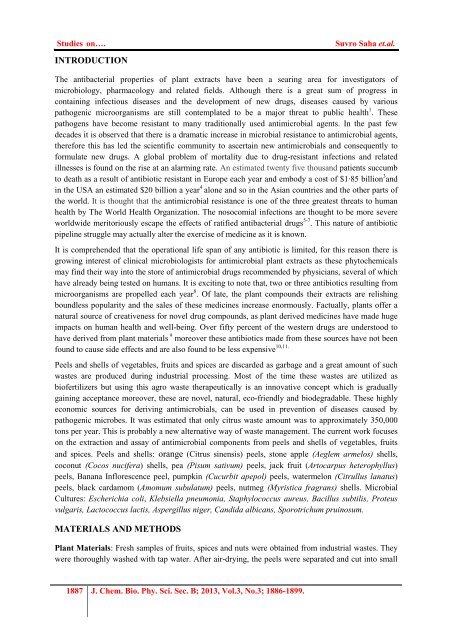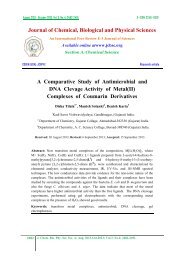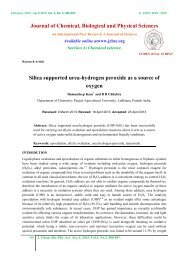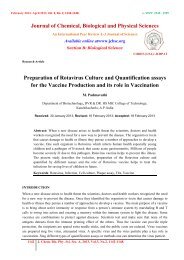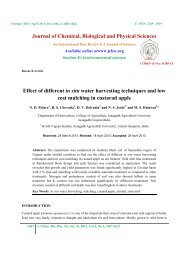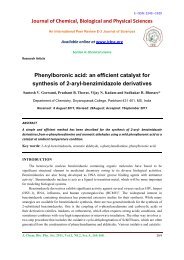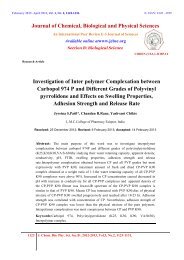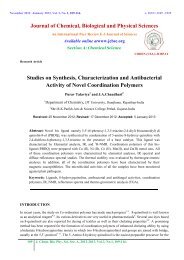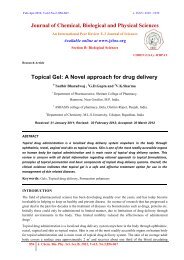Studies on Antimicrobial Properties of Vegetable, Fruit & Spice ...
Studies on Antimicrobial Properties of Vegetable, Fruit & Spice ...
Studies on Antimicrobial Properties of Vegetable, Fruit & Spice ...
- No tags were found...
You also want an ePaper? Increase the reach of your titles
YUMPU automatically turns print PDFs into web optimized ePapers that Google loves.
<str<strong>on</strong>g>Studies</str<strong>on</strong>g> <strong>on</strong>….INTRODUCTIONSuvro Saha et.al.The antibacterial properties <strong>of</strong> plant extracts have been a searing area for investigators <strong>of</strong>microbiology, pharmacology and related fields. Although there is a great sum <strong>of</strong> progress inc<strong>on</strong>taining infectious diseases and the development <strong>of</strong> new drugs, diseases caused by variouspathogenic microorganisms are still c<strong>on</strong>templated to be a major threat to public health 1 . Thesepathogens have become resistant to many traditi<strong>on</strong>ally used antimicrobial agents. In the past fewdecades it is observed that there is a dramatic increase in microbial resistance to antimicrobial agents,therefore this has led the scientific community to ascertain new antimicrobials and c<strong>on</strong>sequently t<strong>of</strong>ormulate new drugs. A global problem <strong>of</strong> mortality due to drug-resistant infecti<strong>on</strong>s and relatedillnesses is found <strong>on</strong> the rise at an alarming rate. An estimated twenty five thousand patients succumbto death as a result <strong>of</strong> antibiotic resistant in Europe each year and embody a cost <strong>of</strong> $1·85 billi<strong>on</strong> 3 andin the USA an estimated $20 billi<strong>on</strong> a year 4 al<strong>on</strong>e and so in the Asian countries and the other parts <strong>of</strong>the world. It is thought that the antimicrobial resistance is <strong>on</strong>e <strong>of</strong> the three greatest threats to humanhealth by The World Health Organizati<strong>on</strong>. The nosocomial infecti<strong>on</strong>s are thought to be more severeworldwide meritoriously escape the effects <strong>of</strong> ratified antibacterial drugs 5-7 . This nature <strong>of</strong> antibioticpipeline struggle may actually alter the exercise <strong>of</strong> medicine as it is known.It is comprehended that the operati<strong>on</strong>al life span <strong>of</strong> any antibiotic is limited, for this reas<strong>on</strong> there isgrowing interest <strong>of</strong> clinical microbiologists for antimicrobial plant extracts as these phytochemicalsmay find their way into the store <strong>of</strong> antimicrobial drugs recommended by physicians, several <strong>of</strong> whichhave already being tested <strong>on</strong> humans. It is exciting to note that, two or three antibiotics resulting frommicroorganisms are propelled each year 8 . Of late, the plant compounds their extracts are relishingboundless popularity and the sales <strong>of</strong> these medicines increase enormously. Factually, plants <strong>of</strong>fer anatural source <strong>of</strong> creativeness for novel drug compounds, as plant derived medicines have made hugeimpacts <strong>on</strong> human health and well-being. Over fifty percent <strong>of</strong> the western drugs are understood tohave derived from plant materials 9 moreover these antibiotics made from these sources have not beenfound to cause side effects and are also found to be less expensive 10,11.Peels and shells <strong>of</strong> vegetables, fruits and spices are discarded as garbage and a great amount <strong>of</strong> suchwastes are produced during industrial processing. Most <strong>of</strong> the time these wastes are utilized asbi<strong>of</strong>ertilizers but using this agro waste therapeutically is an innovative c<strong>on</strong>cept which is graduallygaining acceptance moreover, these are novel, natural, eco-friendly and biodegradable. These highlyec<strong>on</strong>omic sources for deriving antimicrobials, can be used in preventi<strong>on</strong> <strong>of</strong> diseases caused bypathogenic microbes. It was estimated that <strong>on</strong>ly citrus waste amount was to approximately 350,000t<strong>on</strong>s per year. This is probably a new alternative way <strong>of</strong> waste management. The current work focuses<strong>on</strong> the extracti<strong>on</strong> and assay <strong>of</strong> antimicrobial comp<strong>on</strong>ents from peels and shells <strong>of</strong> vegetables, fruitsand spices. Peels and shells: orange (Citrus sinensis) peels, st<strong>on</strong>e apple (Aeglem armelos) shells,coc<strong>on</strong>ut (Cocos nucifera) shells, pea (Pisum sativum) peels, jack fruit (Artocarpus heterophyllus)peels, Banana Inflorescence peel, pumpkin (Cucurbit apepol) peels, watermel<strong>on</strong> (Citrullus lanatus)peels, black cardamom (Amomum subulatum) peels, nutmeg (Myristica fragrans) shells. MicrobialCultures: Escherichia coli, Klebsiella pneum<strong>on</strong>ia, Staphylococcus aureus, Bacillus subtilis, Proteusvulgaris, Lactococcus lactis, Aspergillus niger, Candida albicans, Sporotrichum pruinosum.MATERIALS AND METHODSPlant Materials: Fresh samples <strong>of</strong> fruits, spices and nuts were obtained from industrial wastes. Theywere thoroughly washed with tap water. After air-drying, the peels were separated and cut into small1887 J. Chem. Bio. Phy. Sci. Sec. B; 2013, Vol.3, No.3; 1886-1899.


